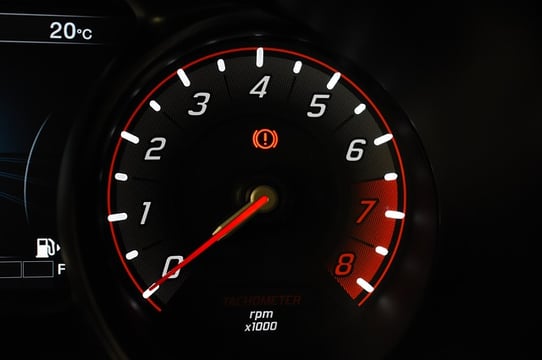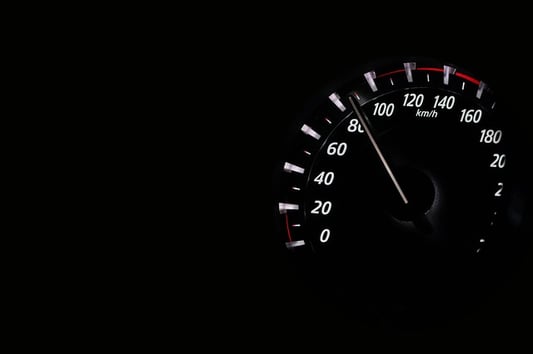what formula to use when finding maximum acceleration
"Whoa, you actually went from zero to sixty there!" Take you ever heard someone use the idiom "zip to sixty" like I did in the higher up example? When someone says something went from "zero to 60," they're actually maxim that things accelerated very chop-chop. Acceleration is the amount by which the velocity of something changes over a set menses of time. In this article, we'll exist talking all near dispatch: what it is and how to calculate it. Buckle up! Dispatch is the rate of change of velocity over a gear up period of fourth dimension. You demand to have both velocity and fourth dimension to summate acceleration. Many people confuse acceleration with velocity (or speed). First of all, velocity is merely speed with a direction, so the two are ofttimes used interchangeably, even though they take slight differences. Dispatch is the rate of change of velocity, significant something is getting faster or slower. You tin utilize the acceleration equation to calculate dispatch. Here is the most common acceleration formula: $$a = {Δv}/{Δt}$$ where $Δv$ is the change in velocity and $Δt$ is the modify in time. You tin can also write the acceleration equation like this: $$a = {v(f) - v(i)}/{t(f) - t(i)}$$ In this dispatch equation, $five(f)$ is the terminal velocity while is the $v(i)$ initial velocity. $T(f)$ is the last fourth dimension and $t(i)$ is the initial time. Another things to keep in mind when using the dispatch equation: At present let'due south breakup the acceleration equation step-past-step in a real case. At present we'll breakdown the acceleration formula pace-by-step using a real instance. A race car accelerates from 15 m/s to 35 m/southward in 3 seconds. What is its average acceleration? Offset, write the acceleration equation. $$a = {five(f) - v(i)}/{t(f) - t(i)}$$ Adjacent, ascertain your variables. $a$ = what we are solving for $$5(f) = 35 1000/due south$$ $$V(i) = 15 m/s$$ $$T(f) = iii s$$ $$T(i) = 0 s$$ Now, plug your variables into the equation and solve: $$A = {{(35 - 15)chiliad}/{s}/{(3 - 0)s}$$ $$A = {(35 - 15)}/{(iii - 0)} g/due south^ii$$ $$A = {20/three} 1000/s^2$$ $$A = 6.66 thousand/s^2$$ Let's try some other case. A cyclist traveling at 23.two m/s comes to a complete stop in ane.5 $s$. What was her deceleration? First, write the acceleration equation. $$a = (5(f) - v(i)) ÷ (t(f) - t(i))$$ Next, define your variables. a = what we are solving for $$V(f) = 0 m/s$$ $$V(i) = 23.2 chiliad/s$$ $$T(f) = 1.4 s$$ $$T(i) = 0 s$$ Now, plug your variables into the equation and solve: $$A ={{(0 - 23.two)m}/s}/{(one.4 - 0)s}$$ $$A = {0 - 23.2}/{1.four - 0} thou/s^2$$ $$A = -23.2/one.four grand/southward^two$$ $$A = -sixteen.57 m/{s^2}$$ Wondering how to calculate acceleration using a unlike formula? There are several other mutual acceleration formulas. Angular acceleration is the charge per unit at which the angular acceleration of a rotating object changes with respect to time. Hither is the angular dispatch equation: $$a = {\change \in \athwart \velocity}/{\change \in \time}$$ Centripetal acceleration is the rate of motion of an object inwards towards the center of a circle. Here is the centripetal dispatch equation: $$a(c) = {v^two}/r$$ $a(c) $= dispatch, centripetal $five$ = velocity $r$ = radius Acceleration is the rate of change of velocity over a set menstruation of time. Y'all calculate acceleration by dividing the change in velocity by the change in fourth dimension. Looking for other science explanations? We suspension downwards electrical energy and how to place the unlike types of cloudswith our expert guides. Working on a enquiry paper but aren't sure where to offset?Then check out our guide, where we've nerveless tons of high-quality research topics you can utilize for free. Demand aid with English language class—specifically with identifying literary devices in texts yous read? Then y'all'll definitely want to take a look at our comprehensive explanation of the most of import literary devices and how they're used.
What Is Dispatch?
What Is the Acceleration Formula?

How to Calculate Acceleration: Step-by-Step Breakdown
2 Other Common Dispatch Formulas
Athwart Acceleration Formula
Centripetal Acceleration Formula
Key Takeaways
What's Adjacent?

Well-nigh the Author
Hayley Milliman is a former teacher turned writer who blogs about education, history, and technology. When she was a instructor, Hayley's students regularly scored in the 99th percentile thanks to her passion for making topics digestible and attainable. In addition to her work for PrepScholar, Hayley is the author of Museum Hack's Guide to History'southward Fiercest Females.
millertatifechand.blogspot.com
Source: https://blog.prepscholar.com/acceleration-formula-equation
0 Response to "what formula to use when finding maximum acceleration"
Post a Comment